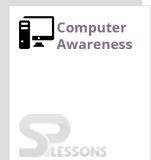 Introduction
Introduction
Computer Awareness Practice Set 47 presents multiple choice Q & A for basics of computers and applications. Computer Awareness Practice Set 48 article, is exceedingly important for candidates preparing for RRB ALP/Technical Exams/Junior Engineer Recruitment, SSC CGL, UPSC (Civil services exam including IAS) Exams and etc.
 Quiz
Quiz
1. The first mechanical calculating machine was made by
- A. William Oughtred
B. Gottfried Leibnitz
C. Blaise Pascal
D. Charles Babbage
- A. ALGOL
B. APL
C. LOGO
D. FORTH
- A. Memory Address Register
B. Memory Data Register
C. Instruction Register
D. Program Counter
- A. Speed of the output device
B. Amount of main memory the CPU can use
C. Cost of the system
D. Where it was purchased
- A. Debugger
B. Editor
C. Spooler
D. All of the above
1. Computer can not do anything without a
- A. Chip
B. Memory
C. Output device
D. Program
- A. Relation
B. Schema
C. Resilience
D. Versatility
- A. Static RAM
B. Dynamic RAM
C. EPROM
D. ROM
- A. 1971-1982
B. 1982-1994
C. 1959-1964
D. 1965-1971
- A. NOR
B. NAND
C. OR
D. NOT
1. The purpose of an application program is to
- A. Convert program written in high level language to machine language
B. Meet specific user needs
C. Allow the operating system to control resources better
D. Make off-line equpment run better
- A. Interpreter
B. Compiler
C. Assembler
D. Decompiler
- A. Napier
B. Babbage
C. Pascal
D. Leibnitz
- A. data consists of numbers
B. short access time is required
C. each stored word is processed differently
D. data naturally needs to flow in and out in the serial form
- A. 1942
B. 1976
C. 1950
D. 1992



